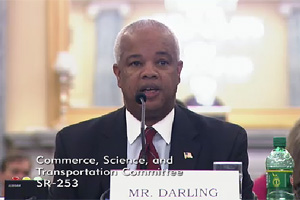FMCSA's Scott Darling Promises Safety Fitness Determination Rule This Month

“Before the end of this month we will publish the safety fitness determination proposal,” Darling announced Jan. 11 in Washington. “It will change the agency’s safety rating process by incorporating current on-road safety performance data. We’ll also complete the initial implementation of a new [online] unified registration system. We will soon publish the proposed rule on entry level driver training. We also plan to publish the final rule later this year. We are implementing Phase 3 of [the Compliance, Safety, Accountability program] to better identify at-risk carriers so that we can intervene more quickly. This year, we are setting a high bar for ourselves as we advance our safety mission.”
Darling, who has been serving in the acting role since August, told Transport Topics that he’s not letting his ongoing lack of congressional approval change his approach.
“I’m going to come to work every day,” he said. “I’m going to do my job. The work that we do is important because safe trucking moves the economy. When Congress wants to see me, I will be there.”
As to that work, Darling said, “This is going to be an exciting year for us. We’re going to be working a lot with all our stakeholders to make sure we get the FAST Act provisions implemented as quickly as possible. … We had a big year in 2015, and we have a big year ahead of us in 2016. We are ramping up our efforts to broaden and deepen our partnerships with state and local governments, law enforcement, safety advocates, labor [and] the trucking industry. Our partners are our force multipliers. We perform at our highest level when we work closely with them.”
Among those partners are the National Academies of Science, which Darling said is teaming with FMCSA to study CSA. The agency also is studying the effects on drivers of round-trip commutes to work of more than 150 miles and is considering giving credits to carriers for using advanced safety equipment, enhanced driver fitness measures and fleet safety management tools.
FMCSA’s John Van Steenburg followed Darling by presenting data that showed that while fatal crashes involving large trucks are down since 2004, they are up since 2009, the bottom of the recession. Illinois and New York had the largest decreases, while Oklahoma and California had the largest increases.
The agency’s William Quade said that FMCSA will be proposing standards shortly for entry-level drivers and is planning to launch a pilot program for drivers younger than 21 who have military experience from actual service as well as in the Reserve and the National Guard. Quade added that FMCSA soon will issue a final rule on the drug and alcohol data base but is waiting on the Department of Health and Human Services before it can move ahead on hair testing. Colleague Jeff Loftus noted that under the Unified Registration System, more than 300,000 DOT numbers were taken out of service over the two years that ended in November.
“Contrary to popular belief, we don’t sit in our building in Washington and look for ways to mess with the trucking industry,” Quade said. “The goal is to put in place systems that improve safety. We belief that the safety fitness determination proposal will do that.”

